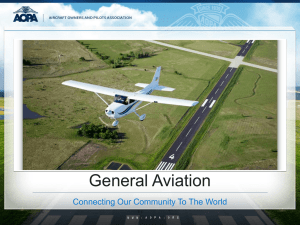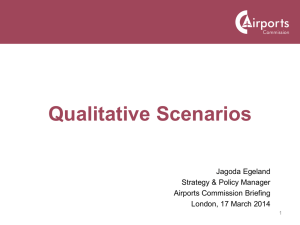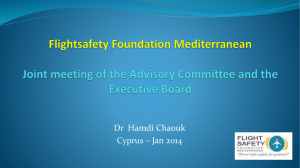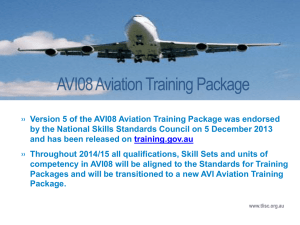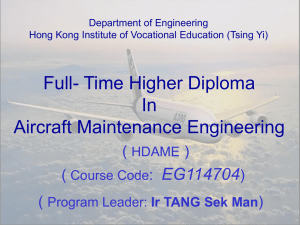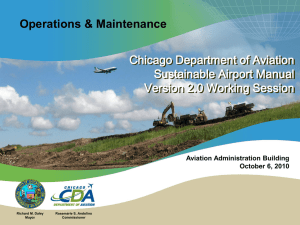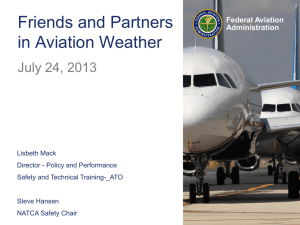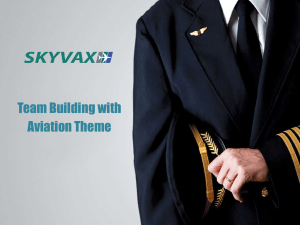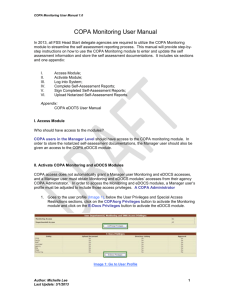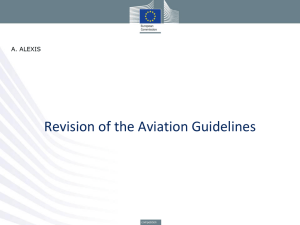1952
advertisement
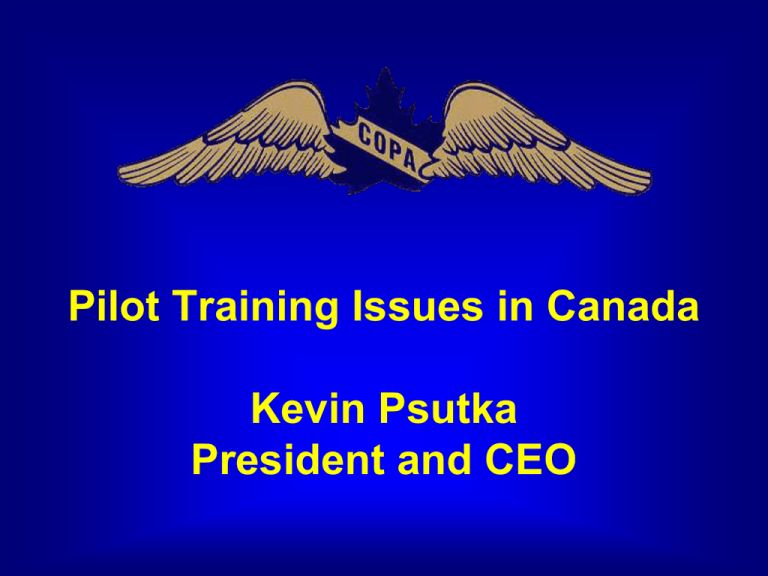
Pilot Training Issues in Canada Kevin Psutka President and CEO Some Definitions General Aviation – everything other than airline or military. Personal Aviation – that sector of General Aviation where aircraft are flown for personal transportation and recreation. When COPA was formed in 1952 There were less than 7,000 pilots in Canada: →Private – 4,560 →Commercial – 2,025 Commercial outnumbered private aircraft: →Private - 966 →Commercial - 1,294 When COPA was formed in 1952 Most recreational flying was in rented certified aircraft There were some homebuilt aircraft and all of these were built from scratch (there were no kits). Technology, regulation and cost are driving the changes Technology, regulation and cost are driving the changes Personal Aviation as a form of transportation Personal Aviation as a form of transportation 1967 Cessna 182 2014 Cessna 182 Personal Aviation as a form of transportation Base Retail Price ($Cdnx1000) 230 Type Design Introductions 4-Seat Entry-Level Airplanes 180 Diamond Star – 2013 Base price $415,000 135 90 Cessna 172 - 1956 $8,200 Grumman Tiger – 1975 $22,500 Diamond Star – 2000 $169,800 45 0 1940 1950 1960 Aircraft Bluebook Price Digest Fall 2009 Vol. 08-03 1970 1980 1990 2000 2010 Some conclusions Private aircraft are by far the largest portion to the Canadian fleet, are increasing both in numbers and as a percentage of the fleet, and have become more sophisticated. Non-certified aircraft are an increasing percentage of the fleet, mostly due to the escalating price and maintenance costs for certified aircraft. Private Pilot Licences Issued 1981 - 2011 7000 6000 5000 4000 3000 2000 1000 0 1981 1991 2001 2011 Commercial Pilot Licences Issued 1981 - 2012 2500 2250 2000 1750 1500 1250 1000 750 500 250 0 1981 1991 2001 2011 Commercial Pilot Licences Issued 2006 2012 Foreign Canadian Foreign Canadian Commercial Pilot Licences Issued 2500 All 2250 2000 Canadian 1750 1500 1250 1000 750 500 250 0 1981 1991 2001 2011 Comparison with 1952 1952 2013 Non-com aircraft 1,000 Commercial aircraft 1,300 29,000 7,000 Non-com pilots Commercial pilots 35,700 24,400 4,500 2,000 Some conclusions The majority of pilots are non-commercial. The number of non-commercial pilots is decreasing. Commercial pilot statistics look relatively good only because of foreign pilot training. →The number of Canadians being trained as commercial pilots is declining. Demand is growing From Statistics Canada report “Air Carrier Traffic at Canadian Airports” Demand is growing Where will pilots come from to fill the demand ?? The traditional source was the military but that has dried up. With a shrinking number of commercial licences being issued each year, the need is greater than ever to attract new people into aviation. Pilot training issues No flight training policy There is a policy vacuum. Politicians do not have to care. Transport Canada has distanced itself from the largest sector of aviation in Canada. Deep cuts continue at Transport Canada. Canada neither knows how many flight schools it needs nor how many pilots it would like to generate for our airlines. No government promotion of aviation as a career Encouraging our youth -COPA’s efforts Security Airport restrictions drive people away from experiencing aviation for the spark that it provides to some. COPA’s efforts to expose people to aviation COPA Flights Insurance for running events such as aviation awareness days. Aviation events calendar (On The Horizon) Defending the right to establish private aerodromes, where security is lower. Kevin Psutka 613-236-4901 (ext 102) KPsutka@copanational.org www.copanational.org GA has no direction There is a policy vacuum regarding GA. Politicians do not have to care. Transport Canada has distanced itself from the largest sector of aviation in Canada. Deep cuts continue at Transport Canada. COPA is forced to do the government’s work in promoting and defending GA. Example: Airport Infrastructure Prior to 1994, Transport Canada had some central control over our system of airports Life was simple - COPA dealt with one agency. Larger airports financially supported smaller airports. But... 1994 The National Airports Policy (NAP) created the framework for divesting (offloading) of 128 airports across Canada. Fed’s goal was to get out of ownership and operation of airports. With no GA policy, the NAP set the stage for abandoning GA. Quotes from the NAP “National Airports Policy provides a framework that clearly defines the federal government's role with airports.” “Much of the Canadian transportation system is overbuilt: 94 per cent of all air passengers and cargo use only 26 of 726 airports” – This is a very important statement – nothing else seems to matter ! 20 years later... 120 airports have been transferred 8 have various impediments to transfer: →Penticton BC, Port Hardy BC, Havre Saint Pierre QC, Natashquan QC, Sept Iles QC, St Anthony NL, Wabush NL, Bonnechere ON Many regional airports have introduced landing and other fees on top of the fuel concession fee that remains in place. Some airport managers are trying to drive GA away to make “excess lands” available for other uses, including non-aviation. 20 years later... Local Airport Authorities have abandoned their satellite airports (except Calgary Springbank) The NAP has succeeded in its original goal but with significant negative consequences for GA. 20 years later... In response to COPA pressure to review the NAP, successive Transport Ministers stand behind this statement: “Local communities are the best placed to assess the importance of (airport) services and to seek support, starting locally, for their continuation.” Is this assumption correct? “Communities are best placed...” Some of the busiest airports in Canada are under stress: Buttonville is closing (6th busiest of all airports in Canada) with insufficient capacity elsewhere to absorb this activity. Toronto Billy Bishop has chased GA away. Oshawa City Council voted down a runway extension. “Communities are best placed...” Edmonton City Centre closed in November 2013 →in 2010 4160 patients were transported to Edmonton hospitals via this airport. St Hubert airport has a class action suit against it for noise →its commitment to remain an airport ceases in 2014. Mascouche airport keeps coming up as a political football. Doing the government’s work: Federal Jurisdiction COPA has over a period of decades spent $600,000, thanks to the memberfunded Freedom to Fly Fund, defending the right to establish an aerodrome without local interference. We finally won at the Supreme Court of Canada in 2010. Federal Jurisdiction “The location of an airport comes within Parliament’s core of exclusive federal jurisdiction.” “The transportation needs of the country cannot be allowed to be hobbled by local interests.” What we won Quebec government appeals of 2 cases (Laferriere, Lacombe) were dismissed and COPA’s arguments accepted. 2 contradicting cases (St. Louis, Van Gool) were overturned. It will be more difficult for our foes to create a case because of these decisions. HOWEVER, the fight is not over... Aeronautics All of Aeronautics Core of Aeronautics (Exclusive Federal Power – Cannot be impaired by provincial or local law) Non-Core Aspects (Federal Jurisdiction – but some aspects may be affected by provincial or local law) Examples of Core Location of aerodrome (as long as it is not in a builtup area), runways, hangars, fuel, support facilities Examples of Non-Core Aspects shorelines, provincial parks, wind farms, taxation Municipalities are pushing hard for jurisdiction: zoning bylaws, site alteration permits, etc etc. Continuing challenges Explaining the wins to those who continue to challenge us. Making sure Transport Canada retains its duty to uphold federal jurisdiction. Wind energy is one example of these challenges. The push for green energy The push for green energy A popular political bandwagon to be on. Legislation is in place (example: Green Energy Act in Ontario) to pave the way for green energy projects. Aviation safety issues are brushed aside because there is no federal or provincial legislation to protect our interests. The push for green energy There is no protection. COPA investigated government position and legal avenues. Transport Canada: Marking and lighting. Protection for relatively few airports under federal zoning regulations. Restrictions on or prohibition of aviation activity. The push for green energy Nav Canada: Examines the impact on IFR operations (minimum enroute and IFR approach procedures). Makes observations on the impact on IFR operations. If turbines are located within affected areas, Nav Canada will raise minimum altitudes or remove the approach(es). Wind Turbine Risk Assessment COPA employed our Freedom to Fly Fund to investigate the safety issues. We brought industry experts together to examine risks and how to mitigate them. Wind Turbine Risk Assessment findings “Steps are necessary to mitigate the risks faced by pilots flying GA aircraft. In particular, the subject matter experts determined that the risks to light and ultra-light aircraft operating in very close proximity to wind turbines during takeoff and landings are significant.” A sample of other challenges COPA is working on Avgas Canada is a follower of the US situation: EPA has committed to a solution by 2017. Date for elimination of 100LL is unknown. Canada only has one refinery of 100LL (Edmonton) Most of eastern Canada fuel comes from the US. Avgas COPA is a member of the Avgas Coalition along with AOPA and others to encourage a solution and educate everyone on the issues and realities. There have been 305 alternatives developed but there are no drop-in replacements for 100LL 94UL Works well with low compression engines 70% of the fleet can use 94UL but they only burn 30% of the avgas consumed. Developing more than one solution is not profitable for the fuel companies. Near term threats are environmental groups with deep pockets and one remaining lead supplier. COPA’s International efforts Regulation is Canada frequently gets its start at the international level The International Civil Aviation Organization (ICAO) sets the standard for aviation in the world. →Primarily aimed at airline travel GA is frequently forgotten or unnecessarily caught in regulation. IAOPA Formed in 1962 to gain recognition for the unique needs of general aviation operations among States in their regulation of the international civil aviation community. Developing ICAO standards and recommend practices it must accommodate general aviation’s operating profiles and capabilities. IAOPA Priorities Develop uniform standards for establishment and use of airspace classes. Ensure that emerging communications, navigation and surveillance (CNS) equipment requirements are appropriate and financially feasible for GA. Reduce language proficiency requirements for pilots operating VFR outside Class A, B and C airspace. Accept aeroplanes not holding State certified type certificates, with a MGTOM of less than 750 kg., for international use. COPA and IAOPA I am VP for North America. Director Frank Hofmann is IAOPA rep at ICAO. Is there a need for COPA? Quote from Director General Civil Aviation from speech at COPA’s 2012 Fly-in AGM: “I firmly believe that without your organization aviation in Canada would be without one of its most powerful voices.” Kevin Psutka 613-236-4901 (ext 102) KPsutka@copanational.org www.copanational.org
